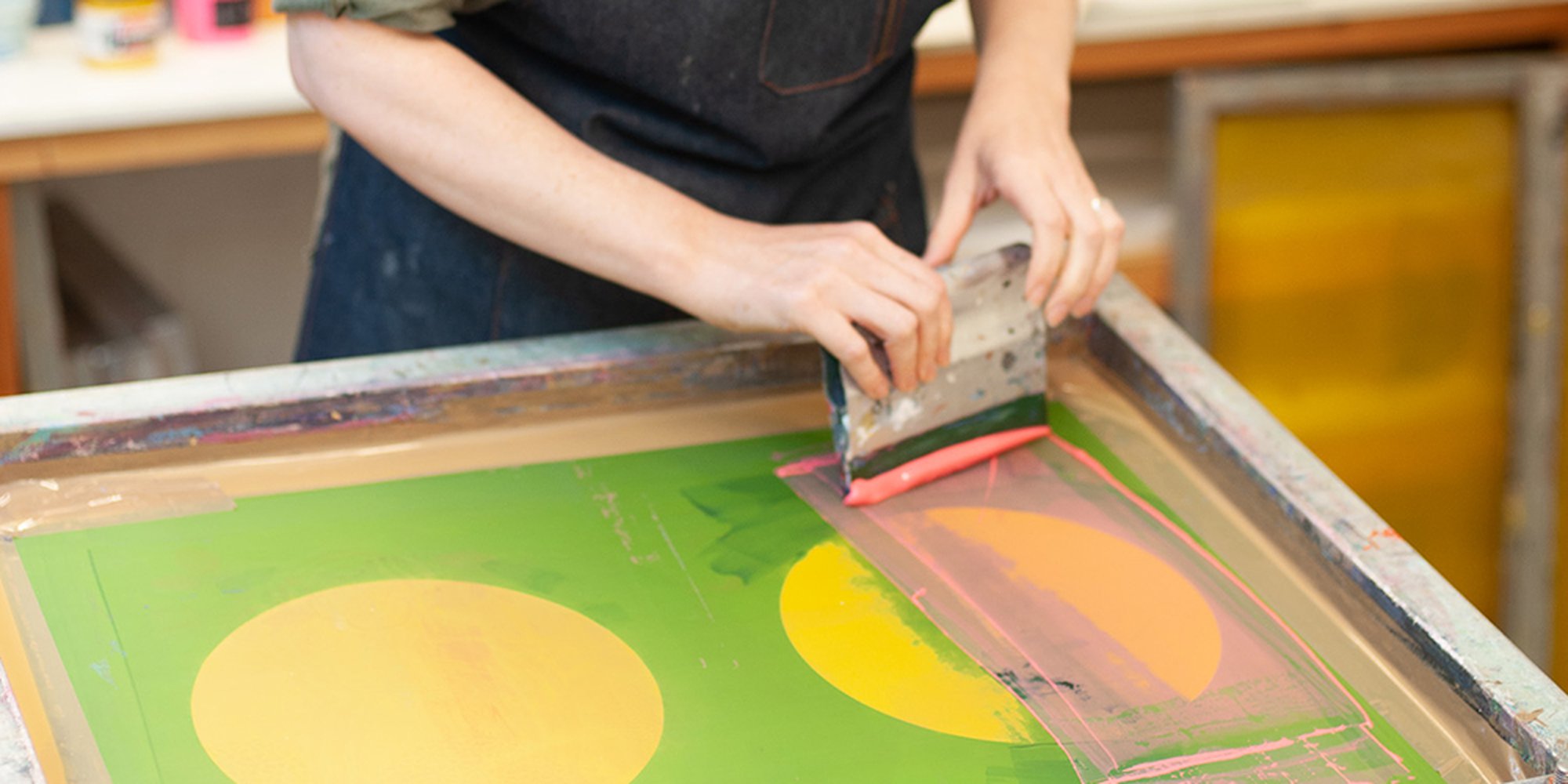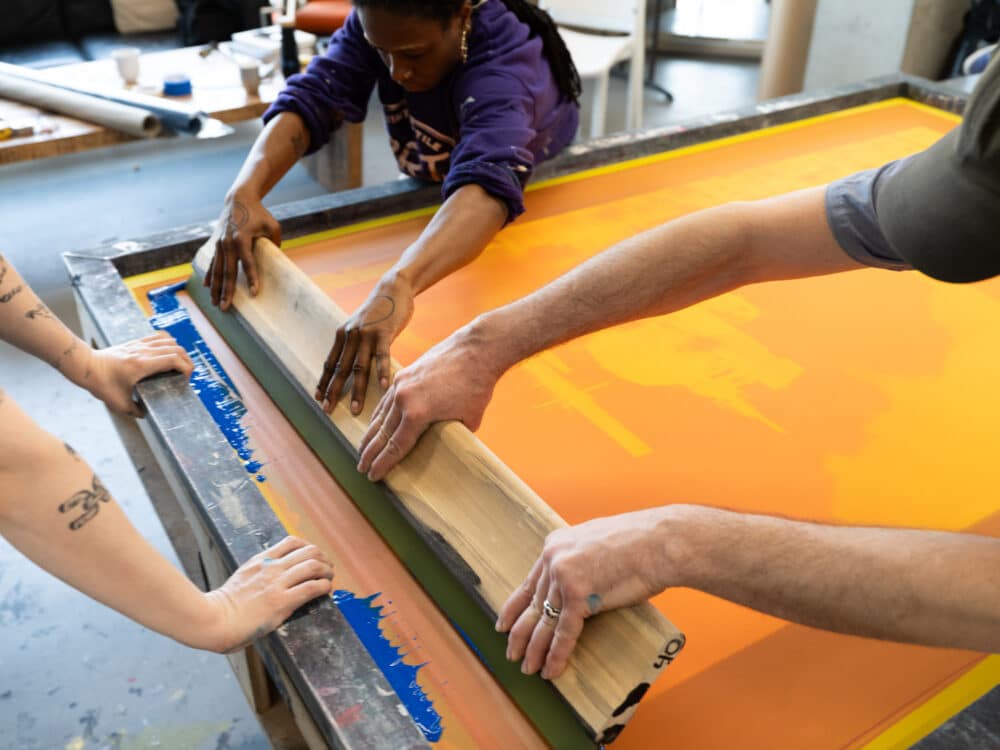ChatGPT said: 10:9 Design Company FAQs: answers to your top questions about their services
Discover the Numerous Sorts Of Screen Printing Techniques for Your Next Task
Screen printing provides a varied series of strategies that can improve any imaginative task. From standard approaches like serigraphy to modern developments such as direct-to-garment printing, each method has its special benefits. Specialized choices, consisting of metallic and eco-friendly inks, present much more opportunities. Recognizing these methods can substantially impact the final result. The obstacle exists in picking the most suitable technique for certain demands and wanted results. What variables should one think about?

The Essentials of Screen Printing
Screen printing might appear complicated, it is essentially a straightforward procedure that entails moving ink with a mesh screen onto various surfaces. The strategy begins with the production of a stencil, which defines the design to be printed. This pattern is connected to a mesh screen, usually made of polyester or nylon. Once the stencil remains in place, ink is put on the screen and pressed with the mesh using a squeegee, causing the preferred pattern being printed on the underlying product.
Screen printing can be executed on a variety of substrates, consisting of plastic, material, and paper, making it a flexible choice for numerous jobs. The process enables elaborate designs and vivid shades, making it popular in industries such as marketing, fashion, and art. Comprehending these basics outfits individuals with the foundational knowledge needed to discover more sophisticated strategies in screen printing.
Traditional Screen Printing Techniques
Typical screen printing strategies have actually been employed for centuries, protecting the workmanship and creativity of this technique. This strategy makes use of a mesh screen to transfer ink onto a substratum, such as textile or paper, enabling durable and vibrant styles. The procedure begins with producing a pattern, which obstructs particular locations of the screen to manage where the ink will be applied.
One prominent method is serigraphy, usually used for restricted editions and imaginative prints. An additional is using water-based inks, which are green and offer a soft feeling on fabrics - 10:9 Design reviews. Additionally, conventional approaches can consist of hand-operated printing, where craftsmens use ink with a squeegee, making sure precision and focus to information
These techniques continue to be valued in the industry for their responsive quality and the special appearances they generate, attracting both developers and customers who appreciate the heritage of screen printing.
Digital Screen Printing Innovations
As the demand for faster manufacturing and modification in the printing industry has actually risen, digital screen printing innovations have become a game-changer. This technology blends traditional screen printing techniques with electronic processes, permitting fast prototyping and intricate designs that were previously hard to accomplish. One significant innovation is the introduction of direct-to-garment (DTG) printing, which promotes top notch, full-color prints on various fabrics without the demand for screens. Furthermore, innovations in ink formulations have actually caused green choices that preserve vivid shades while decreasing environmental impact. The usage of automated systems further improves production, lowering labor prices and boosting precision. These innovations not only provide to little set orders and tailored styles but additionally enable quicker turnaround times, making them perfect for businesses concentrated on meeting client needs in a busy market. Digital screen printing, subsequently, represents a necessary advancement in the domain name of printing techniques.
Specialty Screen Printing Methods
Checking out specialty screen printing approaches discloses a varied array of techniques that press the limits of creative thinking and functionality in the printing industry. Amongst these, glow-in-the-dark inks provide an unique visual impact, making designs come active in low-light conditions. Metallic inks, known for their shimmering surface, include a touch of deluxe to published materials. One more innovative method is discharge printing, which gets rid of color from the material rather than adding ink, causing a soft, classic feel. High-density printing develops an increased structure on the surface, improving tactile involvement. In addition, water-based inks are acquiring popularity for their lively shades and minimized environmental influence. Each of these specialized techniques accommodates certain design needs, making it possible for brands and artists to produce standout items that reverberate with their target markets. By leveraging these approaches, organizations can elevate their screen printing jobs to new elevations, making certain memorable impressions.
Eco-Friendly Screen Printing Options
Environmentally friendly screen printing alternatives are gaining traction as the industry changes in the direction of sustainability. Lasting ink choices and using biodegradable materials are vital parts in minimizing the ecological effect of the printing procedure. By taking on these methods, screen printers can add to an extra sustainable future while preserving top quality results.
Sustainable Ink Selections

Biodegradable Products Usage
As the screen printing sector advances, the incorporation of biodegradable products is coming to be significantly essential for eco mindful techniques. Manufacturers and developers are currently exploring inks and substratums made from all-natural, sustainable sources that break down a lot more efficiently than standard counterparts. These eco-friendly choices reduce plastic waste and decrease environmental effect, straightening with the expanding need for sustainable items.
Typical examples include water-based inks check here and natural cotton materials, both of which minimize dangerous chemicals and advertise eco-friendliness. Brand names that take on these materials frequently improve their market allure, bring in customers that focus on sustainability. As recognition of environmental issues continues to rise, the shift towards naturally degradable materials in screen printing is likely to obtain energy, cultivating a greener sector criterion.
Choosing the Right Technique for Your Task
Just how can one establish one of the most appropriate screen printing method for a specific job? The decision depends upon several aspects, including the material to be published on, the intricacy of the design, and the preferred manufacturing volume - 10:9 Design Screen Printing Texas. Direct-to-garment printing is perfect for complex layouts with numerous colors, while standard screen printing succeeds for larger runs of simpler graphics.
Furthermore, factor to consider of the end-use of the published item is necessary. For exterior applications, methods that supply sturdiness and weather condition resistance, such as plastisol ink, may be favored. Alternatively, environmentally-conscious jobs might gain from biodegradable products or water-based inks.
Inevitably, recognizing the project's unique requirements enables an informed selection, making sure both aesthetic allure and functional durability. By evaluating style intricacy, product compatibility, and production scale, one can effectively pick the most ideal screen printing technique to fulfill their project's goals.
Regularly Asked Inquiries
What Is the History of Screen Printing?
Screen printing came from in ancient China around 1000 ADVERTISEMENT, developing with Japan and Europe. By the 20th century, it ended up being prominent in business art and style, reinventing just how layouts were produced and dispersed globally.

How Do I Prepare Artwork for Screen Printing?
To prepare art work for screen printing, one need to guarantee high resolution, make use of a suitable color mode, develop different layers for each shade, and convert message to outlines, ensuring compatibility with the printing process and wanted outcome.
What Products Are Finest for Screen Printing?
The finest materials for screen printing consist of high-quality inks, durable displays, and appropriate substrates like cotton, polyester, or blends. In addition, utilizing proper solution and squeegees can enhance the printing process and outcomes.
Can I Evaluate Publish in your home?
Yes, screen printing in the house is possible. With the best products, setup, and methods, people can create high-quality prints. Nonetheless, mindful factor to consider of work area and equipment is important for successful results.

What Are Usual Blunders in Screen Printing?
Common blunders in screen printing consist of inappropriate exposure times, insufficient ink consistency, imbalance of displays, not enough cleansing of products, and ignoring to examine prints. These mistakes can compromise the high quality and precision of the last item.
Screen printing may seem facility, it is fundamentally an uncomplicated process that includes transferring ink with a mesh screen onto different surfaces. As the need for faster production and modification in the printing industry has surged, digital screen printing technologies have emerged as a game-changer. Checking out specialized screen printing methods reveals a diverse range of techniques that push the borders of imagination and functionality in the printing industry. The ideal products for screen printing include top notch inks, sturdy displays, and appropriate substrates like cotton, polyester, or blends (10:9 Design Screen Printing Texas). Typical errors in screen printing consist of inappropriate direct exposure times, insufficient ink consistency, misalignment of screens, inadequate cleansing of materials, and overlooking to test prints